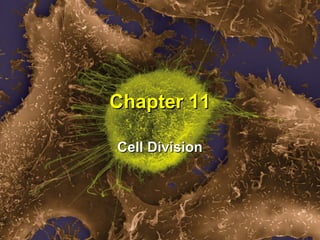
Chapter 11
- 2. Terminology • Nucleic Acid • Gene • Chromatin – Histones – Nucleosomes – Linker DNA • Chromosome
- 3. Terminology • Plasmid • Condensed Chromosome • Centromere • Telomere • Sister Chromatids
- 4. Cell Division The life cycle of an organism is linked to cell division. Unicellular organisms use cell division primarily for reproduction. In multicellular organisms, cell division is also important in growth and repair of tissues.
- 5. Cell Division Reproductive signal :To initiate cell division Replication Segregation :Distribution of the DNA into the two new cells Cytokinesis: Separation of the two new cells
- 6. Prokaryotic Cell Division Binary Fission External factors such as nutrient concentration and environmental conditions are the reproductive signals that initiate cell division. For many bacteria, abundant food supplies speed up the division cycle.
- 7. Binary Fission Plasmid
- 8. Eukaryotic Cell Division Highly Controlled/ Regulated Two Types Mitosis separates them into two new nuclei, identical to the parent cell. Meiosis is nuclear division in cells involved in sexual reproduction. The cells resulting from meiosis are not identical to the parent cells.
- 9. Cell Cycle The period between cell divisions, divided into mitosis/cytokinesis and interphase.
- 10. Interphase The cell nucleus is visible and cell functions including replication occur. Begins after cytokinesis and ends when mitosis starts. Has three subphases: G1, S, and G2
- 11. Interphase Subphases G1: Gap 1 Between end of cytokinesis and onset of S phase; chromosomes are single, unreplicated structures (Normal Cell Function) S Phase DNA replicates; one chromosome becomes two sister chromatids G2: Gap 2 End of S phase, cell prepares for mitosis M phase Mitosis and cytokinesis occur during this phase
- 12. Centrosomes • Determines the plane of cell division • It doubles during S phase and will determine the spindle orientation • Each centrosome can consist of two centrioles • The centrosomes move to opposite ends of the nuclear envelope during G2-to-M transition. • Orientation determines the plane at which the cell will divide and the spatial relationship of the two new cells. • Plants don’t have centrosomes (but have something similar)
- 13. Mitosis Can be divided into phases: • Prophase • Prometaphase • Metaphase • Anaphase • Telophase
- 14. Prophase Cohesin disappears except at the centromere; chromatids become visible. Kinetochores, for movement, develop in the centromere regions. Centrosomes serve as mitotic centers or poles; Microtubules form between the poles to make the spindle.
- 15. Prometaphase The nuclear envelope breaks down. Chromosomes consisting of two chromatids attach to the kinetochore mictotubules.
- 16. Metaphase • Chromosomes line up at the midline of the cell.
- 17. Anaphase • The separation of sister chromatids • Cohesin is hydrolyzed by separase. • Critical check point
- 18. Telophase Occurs after chromosomes have separated: •Spindle breaks down •Chromosomes uncoil •Nuclear envelope and nucleoli appear •Two daughter nuclei are formed with identical genetic information
- 19. Cytokinesis Division of the cytoplasm differs in plant and animals. Animals: Contractile Ring
- 20. Cytokinesis Plants: Cell Plate
- 21. Types of Reproduction Asexual - Mitosis The offspring are clones (genetically identical to the parent).
- 22. Types of Reproduction Sexual The offspring are not identical to the parents. It requires gametes created by meiosis; two parents each contribute one gamete to an offspring. Gametes (and offspring) differ genetically from each other and from the parents.
- 23. More Terminology Somatic cells: body cells not specialized for reproduction. Homologous pairs of chromosomes: Each parent contributes one homolog. Genome: all the genetic information in a cell Diploid (2n): Contains two sets of each chromosome Haploid (n): Contains one set of each chromosome Fertilization: Two haploid gametes (female egg and male sperm) fuse to form a diploid zygote
- 24. Karyotype The number, shapes, and sizes of the metaphase chromosomes in a cell. Individual chromosomes can be recognized by length, position of centromere, and banding patterns. Cytogenetics uses karyotypes to aid in the diagnosis of certain diseases.
- 25. Meiosis Consists of two nuclear divisions (1 and 2) but DNA is replicated only once. The function of meiosis is to: • Reduce the chromosome number from diploid to haploid • Ensure that each haploid has a complete set of chromosomes • Generate diversity among the products
- 26. Interphase Prior to Meiosis the cell must commit to sell division moving from the G1 phase to the S phase During S phase the DNA is Replicated During G2 phase the cell prepares for Meiosis
- 27. Prophase 1 Very Long Phase The homologous chromosomes pair: synapsis. The four chromatids of each homologous pair form a tetrad. Chiasmata form between non-sister chromatids. Crossing Over can occur
- 28. Crossing Over Source of Genetic Diversity Form Recombinant Chromatids
- 29. Prophase/Prometaphase 1 • Nuclear Envelope Breaks Down • Spindle Forms • Centrosomes move to the poles • Cohesin is limited to the centromeres
- 30. Metaphase 1 Homologous Paris line up down the Metaphase Plate Independent assortment (how the homologous pairs line up) during Metaphase/Anaphase I also allows for chance combinations. “More Genetic Diversity”
- 31. Anaphase 1 Homologous chromosomes separate
- 32. Telophase 1 Occurs in some organisms Nuclear envelope reaggregates, followed by an interphase called interkinesis. In other organisms, meiosis II begins immediately.
- 33. Meiosis II Similar to Mitosis Differences: 1) DNA does not replicate before meiosis II 2) In meiosis II the sister chromatids may not be identical because of crossing over 3) The number of chromosomes at the equatorial plate in meiosis II is half the number of those in mitosis
- 35. Meiotic Errors Nondisjunction: Homologous pairs fail to separate at anaphase I; sister chromatids fail to separate, or homologous chromosomes may not remain together
- 36. Cell Death Necrosis Apoptosis Cell is damaged or is genetically starved for oxygen programmed cell or nutrients. The cell death. swells and bursts
